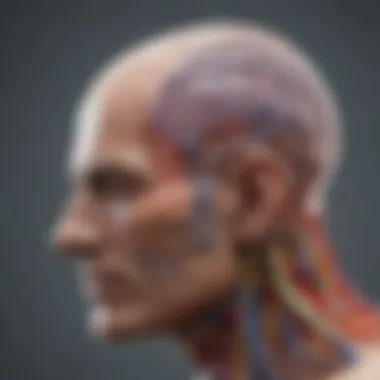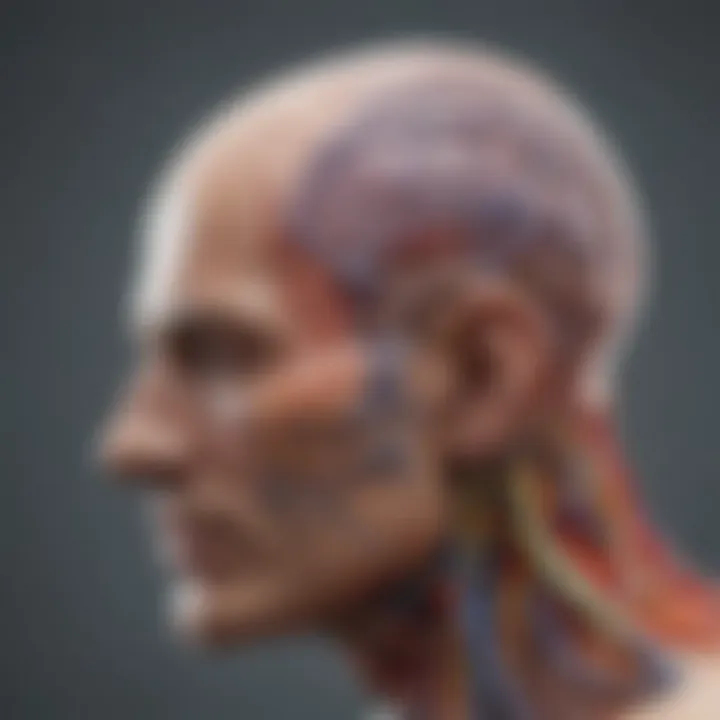Pharmacological Insights into Nerve Pain and Depression


Intro
Nerve pain and depression are complex conditions that often overlap, complicating diagnosis and treatment. Patients frequently experience a range of symptoms, which can impede daily life. This interconnection has attracted attention from various fields, including psychology, neurology, and pharmacology. Understanding how medications interact with biological and psychological systems can lead to more effective management strategies.
Article Overview
Purpose of the Article
This article aims to clarify how medications specifically target nerve pain and depression. It delves into the mechanism of action of different classes of drugs. It also presents insights into patient management, considering factors such as individual responses to treatments.
Relevance to Multiple Disciplines
The dual nature of nerve pain and depression makes this topic relevant across several disciplines. Researchers in neuroscience continue to explore the synaptic mechanisms involved in chronic pain. Psychiatrists analyze how mood disorders can exacerbate perceptions of pain. Pharmacologists study the biochemical pathways through which medications exert effects on both conditions. Thus, forging a comprehensive understanding requires collaboration among these fields.
Research Background
Historical Context
Historically, the approach to treating nerve pain and depression was rudimentary. Physicians often treated these conditions separately, leading to suboptimal outcomes. With recent advances in medical research, there is a growing recognition of their intertwined nature. The understanding of neurobiology has expanded, illuminating how nerve pathways and neurotransmitters link pain and mood disorders.
Key Concepts and Definitions
A few key terms are essential for understanding the interplay between nerve pain and depression:
- Nerve Pain: Also known as neuropathic pain, this condition arises from nerve injury or dysfunction.
- Depression: A mood disorder characterized by persistent feelings of sadness, loss of interest, and various physical symptoms.
- Pharmacotherapy: The use of drugs to manage health conditions.
Both conditions may share common neurological pathways. Medications such as antidepressants can influence pain perception. Meanwhile, pain management may improve mood stability. Therefore, comprehensive treatment plans must consider this relationship.
Foreword to Nerve Pain and Depression
The interplay between nerve pain and depression is significant and complex. Understanding this connection is vital for effective patient management. Both conditions can deeply impact quality of life and often co-occur, leading to greater challenges in treatment. The aim of this section is to clarify what nerve pain and depression are, and how they relate to each other. Recognizing this interaction can lay the groundwork for tailored treatment approaches.
Defining Nerve Pain
Nerve pain, also known as neuropathic pain, arises from damage to the nerve fibers themselves. It can manifest as shooting pain, tingling, burning sensations, or increased sensitivity to touch. Conditions such as diabetes, spinal injuries, and multiple sclerosis are often associated with nerve pain. It is important to differentiate nerve pain from other types of pain. Unlike nociceptive pain, which results from tissue damage, nerve pain is due to abnormal signals in the nervous system. This specificity is essential for appropriate treatment selection.
Understanding Depression
Depression is a mood disorder characterized by persistent feelings of sadness and loss of interest. Symptoms may include changes in appetite, sleep disturbances, fatigue, and difficulty concentrating. The World Health Organization recognizes depression as a leading cause of disability globally. It is important to note that depression can be triggered by various factors, including biological, environmental, and psychological aspects. The challenges in diagnosing and treating depression often lie in its heterogeneous nature.
The Connection Between Nerve Pain and Depression
Research has shown a bidirectional relationship between nerve pain and depression. Individuals suffering from chronic nerve pain are more likely to experience depressive symptoms. Conversely, those with depression may report heightened pain sensitivity. This connection may be due to shared neurobiological pathways. For instance, changes in neurotransmitter levels can affect both mood regulation and pain perception.
Pharmacological Treatments for Nerve Pain
The importance of pharmacological treatments for nerve pain cannot be overstated. Chronic nerve pain, also known as neuropathic pain, often leads to debilitating consequences that affect physical and emotional well-being. Understanding different medication options is crucial for healthcare providers and patients alike. Medications can help manage symptoms, improve quality of life, and facilitate better coping mechanisms. This section explores various pharmacological interventions and highlights their potential benefits and considerations.
Non-Opioid Analgesics
Non-opioid analgesics play a significant role in managing nerve pain. These medications include acetaminophen and nonsteroidal anti-inflammatory drugs (NSAIDs) like ibuprofen and naproxen. They help to reduce inflammation and alleviate pain without the risks associated with opioids.
- Benefits: Non-opioid analgesics are often easier to obtain and have a lower addiction potential. They are suitable for mild to moderate pain and can be used in combination with other therapies for greater effect.
- Considerations: While generally safe, these medications can cause gastrointestinal issues, liver damage with overdoses, and allergic reactions. Patients should use them according to guidelines to prevent adverse effects.
Anticonvulsants
Anticonvulsants have emerged as a popular choice for nerve pain management. Medications such as gabapentin and pregabalin are commonly prescribed for their effectiveness in reducing neuropathic pain.
- Mechanism: These drugs modulate the way nerve signals are transmitted, thus interrupting pain pathways. They can decrease the frequency and intensity of pain.
- Benefits: Anticonvulsants can be beneficial for patients who do not respond to traditional pain medications. They often alleviate burning and tingling sensations associated with nerve pain.
- Considerations: Side effects can include dizziness, drowsiness, and fatigue. Dosage must be carefully managed to avoid complications. Regular follow-up with healthcare providers is necessary to assess efficacy and adjust as needed.
Topical Treatments
Topical treatments are an excellent addition to systemic medications in treating nerve pain. Agents like lidocaine patches or capsaicin cream can provide localized pain relief.
- Application: These treatments are directly applied to the skin over the painful area, providing targeted relief without significant systemic absorption.
- Benefits: They minimize systemic side effects and are suitable for patients who may not tolerate oral medications well. Topical treatments can also be used in conjunction with other therapies for more comprehensive pain management.
- Considerations: Skin irritation may occur with topical treatments. Patients should monitor for any adverse reactions and communicate with their healthcare provider if severe discomfort arises.


Opioids and Their Role
Opioids remain a controversial yet important consideration for nerve pain management, especially in severe cases that do not respond to other therapies. Medications such as oxycodone and morphine are powerful analgesics.
- Mechanism: Opioids bind to specific receptors in the brain and spinal cord, blocking pain signals effectively.
- Benefits: They can provide rapid relief for acute and chronic pain, significantly improving quality of life when used appropriately.
- Considerations: The risks associated with opioid use, including addiction, tolerance, and potential overdose, are significant. It is essential for healthcare providers to assess the patient’s risk factors and consider prescribing the lowest effective dose for the shortest duration possible.
"The careful management of pain through pharmacological treatments requires a comprehensive understanding of each option's benefits and risks. Tailoring treatment plans to individual needs is vital for effective pain management."
"The careful management of pain through pharmacological treatments requires a comprehensive understanding of each option's benefits and risks. Tailoring treatment plans to individual needs is vital for effective pain management."
In summary, pharmacological treatments for nerve pain offer a range of options, each with its own mechanism of action, benefits, and considerations. Understanding these elements can facilitate the development of a tailored approach to manage this challenging condition.
Pharmacological Treatments for Depression
Pharmacological treatments are crucial for managing depression, especially in patients who may experience concurrent conditions such as nerve pain. The importance of medication lies in its ability to alleviate symptoms, restore functionality, and improve the quality of life. Different classes of antidepressants work through various mechanisms to influence neurotransmitter levels in the brain, which can result in significant improvements in mood and daily functioning.
When considering pharmacological treatments for depression, it’s important to evaluate the specific needs of each patient. Factors such as the severity of the depressive disorder, the presence of comorbid conditions, and the individual’s unique biological makeup should guide treatment decisions. While one class of medication may be effective for some patients, it may not yield the same results for others. Therefore, personalized treatment plans are essential.
Selective Serotonin Reuptake Inhibitors (SSRIs)
Selective serotonin reuptake inhibitors, commonly known as SSRIs, are typically the first-line treatment for depression. They work by inhibiting the reabsorption of serotonin in the brain, thus increasing its availability in the synaptic cleft. This enhancement of serotonin levels can lead to improved mood and emotional stability.
Some popular SSRIs include:
- Fluoxetine (Prozac)
- Sertraline (Zoloft)
- Escitalopram (Lexapro)
Patients may experience side effects with SSRIs, such as nausea, insomnia, and sexual dysfunction. However, these medications are often well-tolerated and can provide relief to those who have not had success with other treatments.
Serotonin and Norepinephrine Reuptake Inhibitors (SNRIs)
SNRIs are another class of antidepressants that can be effective in treating depression. They increase the levels of both serotonin and norepinephrine in the brain. By targeting two key neurotransmitters, SNRIs can offer an alternative for patients who do not respond to SSRIs alone.
Examples of SNRIs include:
- Venlafaxine (Effexor)
- Duloxetine (Cymbalta)
These medications are particularly beneficial for patients who present with chronic pain alongside depressive symptoms, as they address both aspects simultaneously. Common side effects can include dry mouth, dizziness, and increased heart rate, but they tend to be manageable for many patients.
Tricyclic Antidepressants (TCAs)
Tricyclic antidepressants (TCAs) represent an older class of antidepressants that are still used in certain scenarios today. They work by blocking the reuptake of serotonin and norepinephrine, similar to SNRIs, but they also affect other neurotransmitters. This broader action can lead to a more varied side effect profile.
Medications within this class include:
- Amitriptyline
- Nortriptyline (Pamelor)
TCAs are effective, especially in patients who suffer from both depression and chronic pain. However, they are often associated with more significant side effects, such as weight gain, sedation, and cardiovascular issues, which necessitate careful monitoring.
Monoamine Oxidase Inhibitors (MAOIs)
Monoamine oxidase inhibitors (MAOIs) are among the oldest types of antidepressants. They work by inhibiting the enzyme monoamine oxidase, which breaks down neurotransmitters like serotonin, norepinephrine, and dopamine. This inhibition allows for increased levels of these neurotransmitters in the brain.
Commonly prescribed MAOIs include:
- Phenelzine (Nardil)
- Tranylcypromine (Parnate)
While MAOIs can be effective, they require dietary restrictions to avoid dangerous interactions with certain foods containing tyramine. This complicates their use and makes patient education essential. These medications may be considered for patients who do not respond to other treatment classes.
Dual Treatment Approaches
Dual treatment approaches address the complex relationship between nerve pain and depression. Both conditions frequently occur together, influencing each other and potentially complicating treatment. Managing them as comorbid issues enhances overall treatment efficacy. Combining therapies can lead to improved patient outcomes and a more comprehensive understanding of the underlying mechanisms.
Importance of Combined Therapy
Combining therapies for nerve pain and depression offers multiple advantages. First, it targets both conditions simultaneously, which can lead to faster symptom relief compared to treating one condition alone. This approach acknowledges that untreated pain can exacerbate depression, while unaddressed depressive symptoms can amplify perceptions of pain. Therefore, simultaneous treatment is essential.


Moreover, patients often experience better quality of life when both conditions are managed together. A multi-faceted strategy can reduce medication dosage, minimizing potential side effects from individual medications. Combining pharmacological approaches, such as antidepressants with pain relievers, can prove beneficial. Patients need to be aware of how each medication works and the rationale behind their use in synergy.
Common Comorbidities
Comorbid conditions related to nerve pain and depression often include anxiety disorders, chronic fatigue syndrome, and fibromyalgia. For instance, anxiety can intensify perceptions of nerve pain, while chronic pain can lead to feelings of sadness and helplessness, exacerbating depressive symptoms. Understanding these comorbidities is vital to fine-tuning treatment strategies.
- Chronic Fatigue Syndrome: Fatigue can hinder the management of both nerve pain and depression. Adequate rest and lifestyle modifications are often required.
- Fibromyalgia: This condition shares symptoms with both nerve pain and depression, suggesting that treatments addressing fibromyalgia may be applicable to manage comorbid symptoms.
Recognizing these coexisting conditions allows clinicians to tailor interventions and provides patients a clearer picture of their health.
Patient-Centered Treatment Plans
Creating patient-centered treatment plans involves developing protocols that consider individual needs and preferences. Treatment should not only address specific symptoms of nerve pain and depression but also consider the patient’s lifestyle, goals, and concerns. Involvement of patients in their own treatment decisions fosters a sense of agency and can improve adherence to suggested therapies.
Important aspects include:
- Assessment of Symptoms: Regular evaluations are essential in tracking progress.
- Adjustments Based on Response: Treatment plans should be flexible. Changes may be necessary as a patient’s condition evolves.
- Incorporating Patient Feedback: Maintaining open communication is crucial for understanding how therapies affect daily life.
A dual approach allows for dynamic adaptation in managing symptoms, ultimately leading to a more holistic healthcare experience for the patient.
A dual approach allows for dynamic adaptation in managing symptoms, ultimately leading to a more holistic healthcare experience for the patient.
Biochemical Mechanisms
Understanding biochemical mechanisms is essential for comprehending how medications affect nerve pain and depression. The interactions at a biochemical level illuminate the underlying processes that contribute to these conditions. This section delves into the intricacies of nerve signal transmission, the role of neurotransmitters, and the impact of inflammation. Each of these elements plays a critical role in how medications alleviate symptoms, which can lead to more effective treatment strategies and better patient outcomes.
Nerve Signal Transmission
Nerve signal transmission involves the process by which neurons communicate with each other, enabling the brain to interpret sensations, such as pain. These signals travel along nerve fibers and are transmitted across synapses, the junctions between neurons. The speed and efficiency of this transmission are crucial. Disruption in this process can result in heightened sensitivity to pain, a common characteristic of neuropathic pain.
Key aspects of nerve signal transmission include:
- Myelination: Myelin is an insulating layer around nerves that enhances signal speed. Damage to myelin can lead to slower transmission and increased pain sensations.
- Action Potential: This is the electrical impulse traveling along the axon of a neuron. Changes in ion concentrations during an action potential are crucial for efficient nerve signaling.
The understanding of these mechanisms helps in identifying potential pharmacological targets for pain relief. For instance, certain medications aim to stabilize or enhance signal transmission, providing relief from nerve pain.
Role of Neurotransmitters
Neurotransmitters are chemical messengers that play a pivotal role in transmitting signals within the nervous system. These molecules facilitate communication between neurons and can influence both mood and pain perception. For nerve pain and depression, several key neurotransmitters are particularly relevant.
Important neurotransmitters include:
- Serotonin: Often linked to mood regulation, serotonin levels are also associated with pain modulation. Low levels can contribute to both depression and increased pain sensitivity.
- Dopamine: This neurotransmitter affects mood and reward systems in the brain. Its dysfunction can lead to depressive states and also influence pain pathways.
- Norepinephrine: Involved in the body's response to stress, norepinephrine plays a role in pain perception and can enhance pain signaling under certain conditions.
By understanding the role of these neurotransmitters, clinicians can better tailor treatments to address both conditions. For example, medications that increase serotonin may help manage depression while also providing some analgesic effects.
Impact of Inflammation
Inflammation is a biological response to harmful stimuli, such as pathogens or tissue injury. In the context of nerve pain and depression, inflammation can exacerbate symptoms and impact recovery. Chronic inflammatory processes can lead to hypersensitivity of pain pathways and alter mood regulation.
Relevant factors regarding inflammation include:
- Cytokines: These signaling proteins can influence both the nervous and immune systems. Pro-inflammatory cytokines have been linked to increased pain sensitivity and depressive symptoms.
- Neuroinflammation: This refers to inflammation within the brain and spinal cord, which can disrupt neurotransmitter systems and contribute to the development of both nerve pain and depression.
Addressing inflammation through medications or lifestyle changes could provide relief for patients suffering from both conditions. This highlights the need for a comprehensive treatment approach that considers the biochemical interplay between inflammation, nerve signaling, and mood regulation.
The intricate balance of biochemical mechanisms is vital for advancing treatment options for nerve pain and depression. A multidisciplinary approach can enhance therapeutic outcomes for patients facing these conditions.
The intricate balance of biochemical mechanisms is vital for advancing treatment options for nerve pain and depression. A multidisciplinary approach can enhance therapeutic outcomes for patients facing these conditions.
Potential Side Effects of Medications
Understanding the potential side effects of medications used for treating nerve pain and depression is critical. As many individuals suffer from both conditions, it is imperative to comprehend how various treatments interact within the body. Knowledge of side effects allows healthcare providers and patients to weigh the benefits against risks effectively. It guides conversations about managing symptoms, ensuring the pursued treatment aligns with individual needs and health conditions.
It is essential to recognize that not all patients will experience side effects, and the severity may vary. However, being informed promotes proactive measures, such as monitoring symptoms and communicating with healthcare professionals. A well-rounded view of these aspects potentially enhances treatment adherence and overall therapeutic outcomes.


Common Side Effects of Pain Medications
Pain medications can affect individuals differently. It is vital to understand the common side effects associated with various classes of pain medications:
- Non-Opioids: Medications like acetaminophen and ibuprofen may cause gastrointestinal issues, liver toxicity, or renal impairments, especially with high dosages.
- Anticonvulsants: Drugs such as gabapentin and pregabalin often lead to dizziness, drowsiness, and peripheral edema.
- Opioids: Opioids like oxycodone and morphine can result in constipation, nausea, respiratory depression, and potential addiction, making their careful management essential.
Awareness of these side effects fosters discussions between patients and providers about alternative options and adjustments in dosage.
Side Effects of Antidepressants
Antidepressants include a range of medications, each with distinct side effects. Familiarizing oneself with these effects can facilitate informed decision-making:
- SSRIs: Selective serotonin reuptake inhibitors, such as fluoxetine and sertraline, may cause weight gain, sexual dysfunction, anxiety, and insomnia.
- SNRIs: Serotonin and norepinephrine reuptake inhibitors, including venlafaxine and duloxetine, can lead to elevated blood pressure, digestive issues, and withdrawal symptoms upon abrupt discontinuation.
- TCAs: Tricyclic antidepressants like amitriptyline might present side effects such as dry mouth, blurred vision, and sedation.
- MAOIs: Monoamine oxidase inhibitors entail dietary restrictions to avoid severe hypertensive crises and may induce dizziness or insomnia.
Patients should be advised to report any adverse effects to optimize medication adjustments and enhance therapeutic efficacy.
Long-term Risk Factors
Prolonged use of both pain medications and antidepressants can introduce various long-term risks. Understanding these factors is fundamental for both healthcare providers and patients:
- Dependency and Addiction: Long-term opioid use poses a significant risk for addiction. Continuous monitoring is necessary to address potential dependency early.
- Tolerance: Over time, patients may develop tolerance, requiring increased doses for the same effect. This can complicate treatment and increase side effects.
- Impact on Mental Health: Some medications can adversely affect mental health, leading to persistent mood alterations or new depressive episodes.
"Recognizing potential side effects is integral to achieving optimal medication management."
"Recognizing potential side effects is integral to achieving optimal medication management."
- Physical Health Issues: Extended use of certain classes of medications can result in organ damage, such as liver or kidney complications.
Emerging Therapies and Alternatives
Emerging therapies and alternatives are becoming increasingly important in the management of nerve pain and depression. Many patients seek non-pharmacological options or complementary treatments, particularly due to the side effects often associated with traditional medications. This section focuses on innovative approaches that show promise in alleviating symptoms, expanding the spectrum of treatment options available for practitioners and their patients.
Neuromodulation Techniques
Neuromodulation techniques present a fascinating frontier in the treatment of nerve pain. These methods involve altering the nerve impulses to reduce pain perception and can be particularly beneficial for patients who do not respond to conventional treatments. One common approach is spinal cord stimulation, which involves implanting a device that delivers electrical impulses to the spinal cord. This can effectively mask nerve pain by changing the way pain signals are processed in the brain.
Other neuromodulation techniques include transcranial magnetic stimulation (TMS) and peripheral nerve stimulation. TMS is a non-invasive procedure that uses magnetic fields to stimulate nerve cells in the brain, while peripheral nerve stimulation targets specific nerves outside the brain and spinal cord. These therapies have shown efficacy, especially in patients with co-morbid conditions like depression, thereby addressing both pain and mood disorders simultaneously. However, it's essential for patients and doctors to discuss the potential risks and benefits before deciding on these interventions.
Cognitive Behavioral Therapy
Cognitive Behavioral Therapy (CBT) stands out as an effective non-drug approach to managing both nerve pain and depression. CBT aims to identify and change negative thought patterns and behaviors that contribute to emotional distress and pain perception. By fostering a better understanding of the interplay between thoughts, emotions, and physical sensations, patients can learn coping strategies to manage their symptoms.
Research indicates that patients engaging in CBT often report reduced pain intensity and improved mood. The structured nature of CBT allows for personalized treatment plans, making it a versatile option for different patients. Integrating CBT into a patient's treatment plan can also enhance the effectiveness of drug therapies, leading to a more holistic approach to management.
Role of Lifestyle Modifications
Lifestyle modifications play a critical role in the treatment of nerve pain and depression. Small adjustments in daily routines can have profound effects on overall well-being. For example, regular physical activity is associated with significant pain reduction and improved mood. Exercise releases endorphins, which are natural mood lifters, while also enhancing physical function and reducing disability resulting from nerve pain.
Diet is another key area where changes can yield benefits. A balanced diet rich in omega-3 fatty acids, antioxidants, and vitamins can help combat inflammation and support brain health. Additionally, practices like mindfulness meditation have gained attention for decreasing stress levels and improving mental resilience.
Closure and Future Directions
The exploration of pharmacological treatments for both nerve pain and depression has revealed significant intersections between the two conditions. Understanding these connections is essential for developing effective management strategies. As we conclude this comprehensive overview, it is pertinent to highlight the key elements that inform future directions in research and treatment methodologies.
Summary of Key Points
- Interrelationship of Symptoms: Nerve pain and depression commonly co-occur, complicating diagnoses and treatment plans.
- Diverse Pharmacological Options: Medications used in the treatment of both conditions range from SSRIs for depression to anticonvulsants for nerve pain.
- Individualized Treatment Plans: The importance of tailoring treatments to each patient’s specific needs cannot be overstated. Healthcare providers should consider the unique presentation of symptoms and potential drug interactions.
- Side Effects and Management: Understanding the potential side effects of various medications allows for better patient management and adherence.
Research Gaps and Opportunities
Despite advancements, there are gaps in our understanding that warrant further exploration:
- Efficacy of Combined Therapies: More research is needed to substantiate the benefits of combining different medication classes.
- Longitudinal Studies: Current studies often lack longitudinal data that could offer insights into the long-term effects of medications on nerve pain and depression.
- Biochemical Mechanisms: Further investigation into the underlying mechanisms of these conditions could yield new therapeutic targets and improve existing treatment protocols.
Looking Ahead: Evolving Treatments
The future of treating nerve pain and depression lies in innovative approaches:
- Personalized Medicine: Advances in genetic testing may allow for more tailored treatments, improving efficacy and reducing side effects.
- Alternative Therapies: Integrating neuromodulation and cognitive behavioral therapy with pharmacological treatment presents new avenues for holistic management.
- Technological Innovations: New technologies may enable remote patient monitoring and real-time adjustments to treatment plans, enhancing patient care.
In summary, the landscape of treating nerve pain alongside depression is progressively evolving. Ongoing research and collaboration between disciplines will be vital in forging effective treatment strategies. The complexity of these conditions necessitates a multifaceted approach, ensuring that patients receive the most comprehensive and effective care possible.



